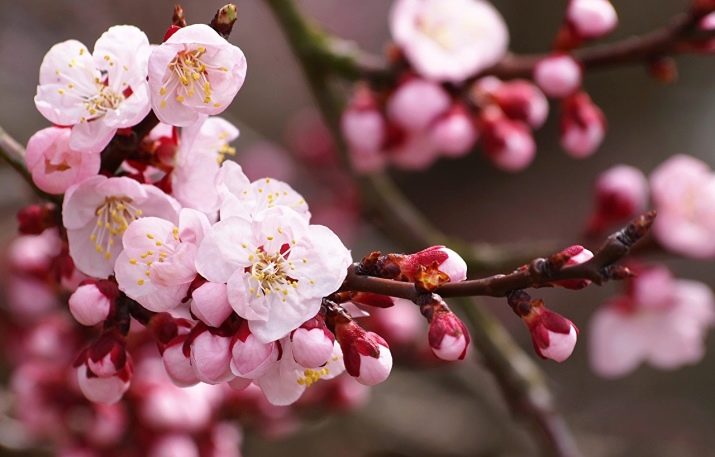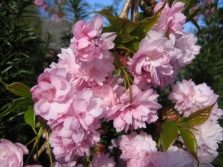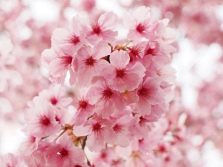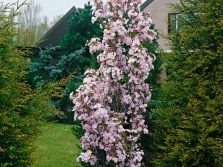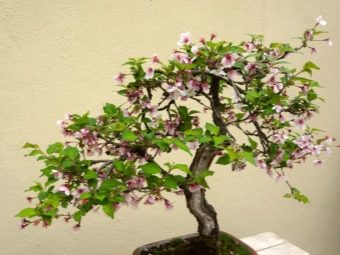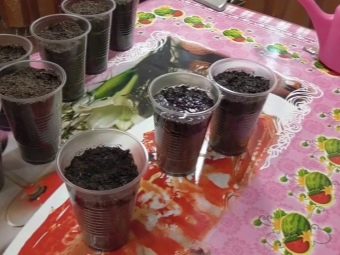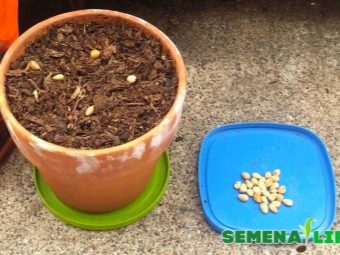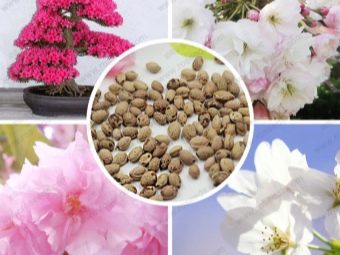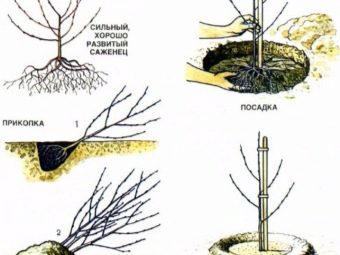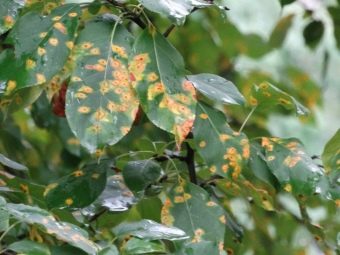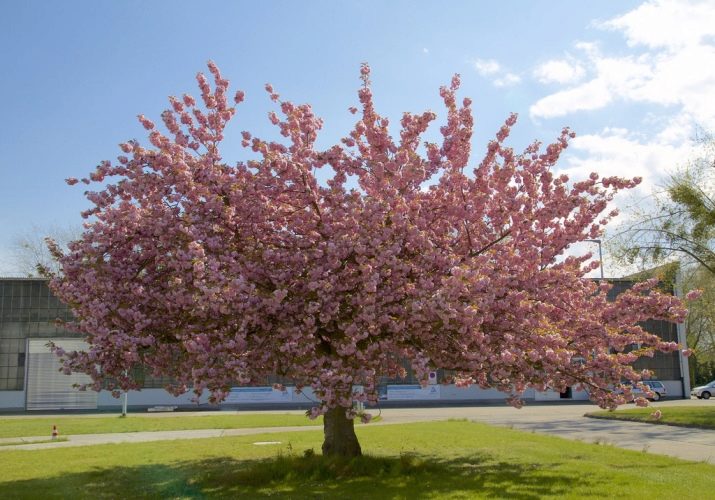How to grow sakura from seed?
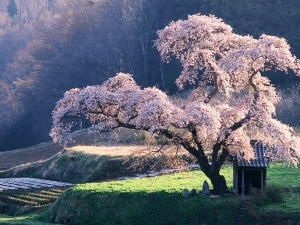
At the word sakura, most people have an association associated with Japan.This plant is indeed the national flower of the Land of the Rising Sun. Its short flowering means the arrival of spring. However, few people know that this symbolic, tender and very beautiful tree can be grown in Russia.
Variety selection
Before you start planting, you should carefully familiarize yourself with its main varieties and decide which variety is suitable for growing more.
Currently, breeders are creating new cultural options that can adapt to certain conditions. As a rule, the main way of breeding a new species is the crossing of already known varieties. For hybridization, species with certain characteristics are used, which in combination create a more resistant to certain growing conditions of the plant.
For example, to create varieties of Spire and Shidare Yoshino, breeders cross the cherry varieties “Yedoenzis”, “Initsisa”, “Lannesian”. The result is a hybrid that looks very beautiful and gentle, and in its qualities is resistant to 30-degree frost.
Good for frost and suitable grade Halle Olivetti. This species is prone to active reproduction, and its aesthetic appearance allows the culture to be used as a spectacular decoration of landscape design.
Suitable for home planting varieties Amanogawa, Shirofugen, Shirotae, Tai Haku. All these species can be grown only by seed. The advantage of varieties is their resistance to stressful growing conditions. The trees are very beautiful.
By the way, some consider the dwarf sakura a separate variety. In fact, this plant is grown using the art of bonsai.
This Japanese phenomenon involves the regulation of growth at the expense of a flat root system. Therefore, many gardeners are trying to grow sakura in miniature in order to decorate their house with it.
There are varieties of sakura that bear fruit, but this does not apply to all varieties. However, Japanese cherries themselves are sour and tasteless, besides, the stone occupies most of the contents of one berry. In Japan, some sakura fruits are used for pickling, drying, or as a seasoning for rice dishes.
Preparation of soil and planting material
Sakura seeds should be prepared in advance for future plants to grow in difficult conditions. Most gardeners choose to plant seeds from China. When preparing planting material, listen to the recommendations of experts.
- Examine the grain structure. If their surface is quite dense, then carefully make small cuts on the shell without touching the inside. Through the holes the shoots will be easier to break through.
- Lay out planting material in warm water (+25.30 degrees) for a day. You can add a little fungicide, it will protect the seeds from the fungus.
- It is necessary to prepare seeds, the number of which is 1.5 times the number of planned trees. This is necessary for reinsurance - not all the material will sprout.
- Start preparing seeds is required immediately after harvest, until they have lost their germination.
An important step in landing is the choice of capacity. In order for future shoots to grow freely and actively develop, it is recommended to take a wide container about 5 cm high. The presence of a drainage system is of particular importance - stable water circulation will provide the culture with the substances required for healthy growth.
Coarse sand is the best option for soil, as Japanese cherry loves slightly acid loose soil. A small proportion of compost and wood ash does not hurt. Ideally, the ground must be ignited.
Methods and scheme of landing
It is possible to germinate a culture from seed at home or by planting a ready-made shoot at the dacha. Familiarize yourself with the rules of cultivation with both options.
Houses
The most suitable time for planting seeds is spring at the end of frosts and the end of summer, the beginning of autumn. Consider the stages of landing.
- We break through the ground furrows approximately 2-2.5 cm deep at a distance of 3 cm from each other.
- We spread the grains in the grooves, slightly deepening them into the ground. The gap between two adjacent instances should not be less than 2 cm.
- Once all the seeds are in the container, sprinkle them with sand so that the top layer is about twice the diameter of one grain.
- The container is covered with polyethylene and placed in the warmest cold room for two months. The process of stratification will contribute to the hardening of future plants.
- After the set time, we take out the container and continue growing under normal conditions at room temperature, providing good illumination and regular moistening.
- When the first shoots appear, they need to be seated. Ideally, every future tree should be planted in a separate container. If this is not possible, then the distance between adjacent shoots should not be less than 10 cm.
In the open ground
Planting a tree can be right at the cottage in the ground. Ready-made shrubs can be easily purchased at a specialty store. But when planting should also observe a number of conditions.
- Dig a hole with a diameter of 45 cm in the soil. When digging, separately remove the upper fertile layer of earth.
- Separate the soil in equal proportions with humus and compost. If the composition was not enough, you can add purchased land.
- By means of pebbles, haydite or crushed stone, we create a drainage system in the pit. Layer must be at least 10 cm.
- Top pour the mixture, which was prepared earlier, so that in the middle of the hole was a hill.
- In the formed hillock exactly we plant an escape, without deepening the root neck.
- Top distribute the remaining mixture, we tamp and pour.
- When the soil settles a little, you need to fall asleep again under the ground sprout.
- As soon as the tree is planted, we next install a support stake and tie a sprout to it.
- Along the perimeter we pierce the ditch to a depth of about 10 cm and fill it with water.
How to care?
To get a beautiful mysterious tree with delicate flowers, It is important to comply with all the conditions for the care of this vulnerable and feminine plant.
- Watering. Care should be taken that the soil is not dry. Special attention should be paid to watering in the period of bud swelling, at the first stage of flowering and in the next couple of weeks - at this time in no case should a moisture deficit be allowed.
- Nutrition. It is important to feed during irrigation. Humus and compost will do. But the tree also needs nitrogen and potassium, therefore we do not forget about mineral fertilizers. If the soil contains little organic matter, it is recommended to feed the plant 10 kg of humus / compost and 15 g of mineral fertilizers once a year. If the soil is more saturated with organic matter, then these elements should be used in a ratio of 5 kg / 8 g. It is important to avoid dressings that oxidize the earth.
- Crop. In order not to provoke the release of resin, it is recommended to form a crown and eliminate dead and diseased branches only before the start of sap flow. It is important to spray cut areas with garden pitch.
- Wintering. The tree, vulnerable and vulnerable to severe conditions, needs to be prepared for winter frosts. To do this, at the end of August we feed it with potash and phosphate mixtures. At this time it is necessary to abandon nitrogen, as it will cause the active development of foliage, which the plant does not have time to lose before winter. A week before the first frosts, we cover the trunk with a special covering material, and the lower part without leaves - with agrofibre. It is important to choose a material that permits oxygen.
- Disease. The tree is most vulnerable to coccomycosis. The disease is characterized by red-brown spots on the leaves at the beginning of summer; gray spores appear on the inner side of the leaf. Formed due to decaying fallen leaves or damp, warm, windy weather. To prevent the occurrence of the disease, you should clean and burn dead leaves in time, dig up the soil immediately after winter.Special fungicides will help to cope with the disease.
- Pests. The most famous insect that likes to feast on sakura is aphid. It is especially dangerous for young trees. Aphid devours the trunk, and the spores of fungi enter the wounds that form, the growth and development of the plant are stopped. To protect the tree from this parasite in advance, it is recommended to coat the trunk with petroleum jelly or glue with double-sided tape. Good help and treatment of insecticide.
It is important to clarify that with the right approach, you can grow Japanese cherries even in the most severe conditions. Residents of the Urals and Siberia may well count on a beautiful garden, decorated with delicate pink flowers. However, for this you should pay special attention to the variety, choosing a frost-resistant variety.
In Siberia, the tree blooms for several weeks. The first petals are revealed in May.
Popularity among Siberian gardeners enjoys "Luiseania Three-bladed", this is one of the plant species, which can also be found under the name "Almond". The tree turns out beautiful, soft and pleases the eye of the garden visitors. Its height reaches 5 meters. Plant care is simple, a variety bred specifically for growing in harsh climates.
Frequent questions about planting sakura arise among residents of the Moscow region. Here the tree begins to bloom in April and continues to bloom in May. It is important to choose the right plot, the place should be well lit by the sun, and the nearest trees should not obscure the young shoot.
Gardeners from the Moscow region prefer such a decorative variety as Kiku Shidare. The main advantage of the variety is frost resistance. The tree grows up to 5 meters in height. Flowering may begin at the end of March. Shrub looks very aesthetic and effectively emphasizes the style of landscape design. However, a gardener should try to keep the soil rich in nutrients, the site is bright and moderately moist.
How to propagate the plant?
The most preferred method of breeding sakura - cuttings. In addition, many plant a plant. As a stock, cherries, plums, cherries, and bird cherries are used, but only a certain culture will be suitable for each variety. Sometimes even sellers of saplings are confused in this matter, because Sakura is not only a cherry, but also the collective name of various forms of plum, peach, almond and other plants.
If the breeding method is chosen by cuttings, it is recommended to use the following expert advice.
- First of all, we wait for the tree to blossom. Shoots must grow to 10-15 cm.
- Dilute "Kornevin" in water at a ratio of 10 g / 5 l.
- We collect cuttings 10 cm long from the shrub and place them in a jar with the Kornevina solution for 12 hours.
- Cooking greenhouse, where the cuttings will be planted under the film.
- We plant the planting material at an angle of 45 degrees, half-screwing it into the ground, and cover the greenhouse with foil.
- After 5-7 weeks, the cuttings will give roots. During this time they need to be watered, to ensure the humidity of the air and soil.
Growing and propagating your own sakura is not so difficult. The main thing is to choose the variety that is most suitable for a particular climate, and also to comply with all the rules of planting and caring for the plant.
For his work, the responsible gardener will be rewarded with a beautiful, elegant, luxurious tree with touching flowers, and his garden will be filled with the mysterious delicate fragrance of Japanese cherry.
About self-growing sakura described in the video below.

